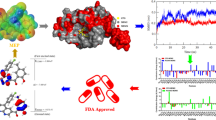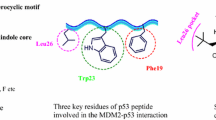Abstract
p53-MDM2/MDMX interaction inhibitors represent the prospective agents for targeted anticancer therapy in tumors expressing wild-type p53 protein. Imidazoline-based MDM2-targeted inhibitors of such type, nutlins, contain halogen-substituted phenyl rings, which dramatically decrease the solubility of compounds in water. The addition of suitable hydrophilic substituents in benzene rings and to imidazoline nitrogen can improve the compound’s water solubility. In this study, we have synthesized novel hydrophilic cis-2,4,5-tris(alkoxyphenyl)imidazolines and studied the influence of N-sulfonyl substituent on protein-protein interaction compared to unsubstituted alkoxy-compounds. The biological activity of the obtained compounds was studied using Western blot analysis on A549, RKO and SH-SY5Y cancer cell lines. It was found that the derivatives are able to inhibit MDM2/MDMX-p53 interaction, promote p53 stabilization and induce p21 expression in the concentrations from 500 nM.








Similar content being viewed by others
References
Varley JM. Germline TP53 mutations and Li-Fraumeni syndrome. Hum Mutat. 2003;21:313–20. https://doi.org/10.1002/humu.10185
Bazanov DR, Pervushin NV, Savitskaya VY, Anikina LV, Proskurnina MV, Lozinskaya NA, et al. 2,4,5-Tris(alkoxyaryl)imidazoline derivatives as potent scaffold for novel p53-MDM2 interaction inhibitors: Design, synthesis, and biological evaluation. Bioorg Med Chem Lett. 2019;29:2364–8. https://doi.org/10.1016/j.bmcl.2019.06.007
Teodoro JG, Evans SK, Green MR. Inhibition of tumor angiogenesis by p53: a new role for the guardian of the genome. J Mol Med. 2007;85:1175–86. https://doi.org/10.1007/s00109-007-0221-2
Purvis JE, Karhohs KW, Mock C, Batchelor E, Loewer A, Lahav G. P53 dynamics control cell fate. Science (80). 2012;336:1440–4. https://doi.org/10.1126/science.1218351
Zhao Y, Aguilar A, Bernard D, Wang S. Small-molecule inhibitors of the MDM2-p53 protein-protein interaction (MDM2 inhibitors) in clinical trials for cancer treatment. J Med Chem. 2015. https://doi.org/10.1021/jm501092z.
Popowicz GM, Czarna A, Holak TA. Structure of the human Mdmx protein bound to the p53 tumor suppressor transactivation domain. Cell Cycle. 2008;7:2441–3. https://doi.org/10.4161/cc.6365
Danovi D, Meulmeester E, Pasini D, Migliorini D, Capra M, Frenk R, et al. Amplification of Mdmx (or Mdm4) Directly Contributes to Tumor Formation by Inhibiting p53 Tumor Suppressor Activity. Mol Cell Biol. 2004;24:5835–43. https://doi.org/10.1128/mcb.24.13.5835-5843.2004
Vassilev LT, Vu BT, Graves B, Carvajal D, Podlaski F, Filipovic Z, et al. In Vivo Activation of the p53 Pathway by Small-Molecule Antagonists of MDM2. Science (80). 2004. https://doi.org/10.1126/science.1092472
Vu B, Wovkulich P, Pizzolato G, Lovey A, Ding Q, Jiang N, et al. Discovery of RG7112: A small-molecule MDM2 inhibitor in clinical development. ACS Med Chem Lett. 2013;4:466–9. https://doi.org/10.1021/ml4000657
Fry DC, Wartchow C, Graves B, Janson C, Lukacs C, Kammlott U, et al. Deconstruction of a nutlin: Dissecting the binding determinants of a potent protein-protein interaction inhibitor. ACS Med Chem Lett. 2013. https://doi.org/10.1021/ml400062c
Liu Y, Wang X, Wang G, Yang Y, Yuan Y, Ouyang L. The past, present and future of potential small-molecule drugs targeting p53-MDM2/MDMX for cancer therapy. Eur J Med Chem. 2019;176:92–104. https://doi.org/10.1016/j.ejmech.2019.05.018
Hu C, Dou X, Wu Y, Zhang L, Hu Y. Design, synthesis and CoMFA studies of N1-amino acid substituted 2,4,5-triphenyl imidazoline derivatives as p53-MDM2 binding inhibitors. Bioorg Med Chem. 2012;20:1417–24. https://doi.org/10.1016/j.bmc.2012.01.003
Hu C, Li X, Wang W, Zhang L, Tao L, Dong X, et al. Design, synthesis, and biological evaluation of imidazoline derivatives as p53-MDM2 binding inhibitors. Bioorg Med Chem. 2011;19:5454–61. https://doi.org/10.1016/j.bmc.2011.07.050
Wang B, Wu S, Liu J, Yang K, Xie H, Tang W. Development of selective small molecule MDM2 degraders based on nutlin. Eur J Med Chem. 2019;176:476–91. https://doi.org/10.1016/j.ejmech.2019.05.046
Joseph TL, Madhumalar A, Brown CJ, Lane DP, Verma C. Differential binding of p53 and nutlin to MDM2 and MDMX: Computational studies. Cell Cycle. 2010;9:1167–81. https://doi.org/10.4161/cc.9.6.11067
Tisato V, Voltan R, Gonelli A, Secchiero P, Zauli G. MDM2/X inhibitors under clinical evaluation: Perspectives for the management of hematological malignancies and pediatric cancer. J Hematol Oncol. 2017;10:1–17. https://doi.org/10.1186/s13045-017-0500-5
Perlovich GL, Kazachenko VP, Strakhova NN, Raevsky OA. Impact of sulfonamide structure on solubility and transfer processes in biologically relevant solvents. J Chem Eng Data. 2014;59:4217–26. https://doi.org/10.1021/je500918t
Arai T, Yokoyama N, Yanagisawa A. A library of chiral imidazoline-aminophenol ligands: Discovery of an efficient reaction sphere. Chem - A Eur J. 2008;14:2052–9. https://doi.org/10.1002/chem.200701439
Bhor S, Anilkumar G, Man KT, Klawonn M, Döbler C, Bitterlich B, et al. Synthesis of a new chiral N,N,N-tridentate pyridinebisimidazoline ligand library and its application in Ru-catalyzed asymmetric epoxidation. Org Lett. 2005;7:3393–6. https://doi.org/10.1021/ol050821e
Belletti D, Tosi G, Riva G, Lagreca I, Galliania M, Luppi M, et al. Nutlin-3 loaded nanocarriers: Preparation, characterization and in vitro antineoplastic effect against primary effusion lymphoma. Int J Pharm. 2015;490:85–93. https://doi.org/10.1016/j.ijpharm.2015.05.029
Dastidar SG, Lane DP, Verma CS. Multiple peptide conformations give rise to similar binding affinities: Molecular simulations of p53-MDM2. J Am Chem Soc. 2008;130:13514–5. https://doi.org/10.1021/ja804289g
Zhong H, Carlson HA. Computational studies and peptidomimetic design for the human p53-MDM2 complex. Proteins Struct Funct Genet. 2005;58:222–34. https://doi.org/10.1002/prot.20275
Shamloo B, Usluer S. P21 in cancer research. Cancers (Basel). 2019;11:1–19. https://doi.org/10.3390/cancers11081178
Sun Q, Guo Y, Liu X, Czauderna F, Carr MI, Zenke FT, et al. Therapeutic implications of p53 status on cancer cell fate following exposure to ionizing radiation and the DNA-PK inhibitor M3814. Mol Cancer Res. 2019;17:2457–68. https://doi.org/10.1158/1541-7786.MCR-19-0362
Lakoma A, Barbieri E, Agarwal S, Jackson J, Chen Z, Kim Y, et al. The MDM2 small-molecule inhibitor RG7388 leads to potent tumor inhibition in p53 wild-type neuroblastoma. Cell Death Disco. 2015;1:1–9. https://doi.org/10.1038/cddiscovery.2015.26
Shangary S, Wang S. Small-molecule inhibitors of the MDM2-p53 protein-protein interaction to reactivate p53 function: a novel approach for cancer therapy. Annu Rev Pharm Toxicol. 2009;49:223–41. https://doi.org/10.1146/annurev.pharmtox.48.113006.094723
Lazebnik YA, Kaufmann SH, Desnoyers S, Poirier GG, Earnshaw WC. Cleavage of poly(ADP-ribose) polymerase by a proteinase with properties like ICE. Nature. 1994;371:346–7. https://doi.org/10.1038/371346a0
Crowley LC, Marfell BJ, Scott AP, Boughaba JA, Chojnowski G, Christensen ME, et al. Dead cert: Measuring cell death. Cold Spring Harb Protoc. 2016;2016:1064–72. https://doi.org/10.1101/pdb.top070318
Kocik J, Machula M, Wisniewska A, Surmiak E, Holak TA, Skalniak L. Helping the released guardian: Drug combinations for supporting the anticancer activity of HDM2 (MDM2) antagonists. Cancers (Basel). 2019;11:1–39. https://doi.org/10.3390/cancers11071014
McDermott SD, Burke PO, Spillane WJ. Basicity of nitrogen–sulphur(VI) compounds. Part 5. Ionization of trisubstituted sulphamides. J Chem Soc Perkin Trans. 2 1984:499–502. https://doi.org/10.1039/P29840000499
Pervushin NV, Senichkin VV, Kapusta AA, Gorbunova AS, Kaminskyy VO, Zhivotovsky B, et al. Nutrient deprivation promotes MCL-1 degradation in an autophagy-independent manner. Biochem. 2020;85:1235–44. https://doi.org/10.1134/S0006297920100119
Author information
Authors and Affiliations
Corresponding authors
Ethics declarations
Conflict of interest
The authors declare no competing interests.
Additional information
Publisher’s note Springer Nature remains neutral with regard to jurisdictional claims in published maps and institutional affiliations.
Supplementary information
Rights and permissions
About this article
Cite this article
Bazanov, D.R., Pervushin, N.V., Savin, E.V. et al. Sulfonamide derivatives of cis-imidazolines as potent p53-MDM2/MDMX protein-protein interaction inhibitors. Med Chem Res 30, 2216–2227 (2021). https://doi.org/10.1007/s00044-021-02802-w
Received:
Accepted:
Published:
Issue Date:
DOI: https://doi.org/10.1007/s00044-021-02802-w




